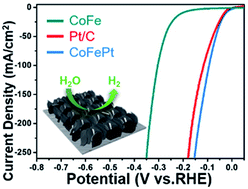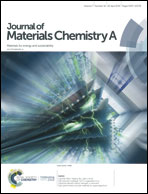Synthesis and performance optimization of ultrathin two-dimensional CoFePt alloy materials via in situ topotactic conversion for the hydrogen evolution reaction†
Abstract
The hydrogen evolution reaction (HER) has been considered as a prospective technology for hydrogen production. Due to large specific area and high surface atomic activity, two-dimensional (2D) materials have advantageous properties for HER. Layered double hydroxides (LDHs) are common 2D materials; however, the limited tunability of electronic structures and valence states have hindered their applications in hydrogen production. Herein, we report an in situ topotactic reduction method to optimize the HER performance of LDH-derived catalysts. Ultrathin 2D CoFe alloy nanosheets were derived from CoFe-LDH arrays on Ni foam via in situ topotactic conversion and feature the ability to stabilize highly dispersed platinum. The as-synthesized CoFe–Pt1% nanosheets exhibited high catalytic activity towards the HER with the overpotential of 18 mV to reach the current density of 10 mA cm−2, which were comparable to the commercial Pt/C catalysts. Especially considering their mass activity, the utilization efficiency of Pt atoms in CoFe–Pt1% is significantly enhanced up to almost 26 times, better than that of Pt/C under the same conditions. This in situ topotactic conversion method reveals applications in the fabrication of high-performance low-cost 2D metal-based catalysts.



 Please wait while we load your content...
Please wait while we load your content...